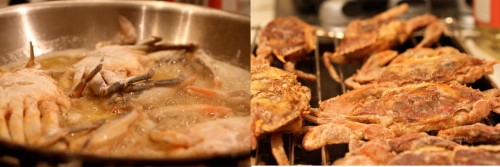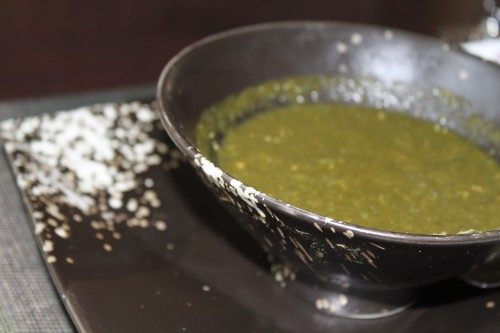Open-Faced Soft-Shell Crab Sandwich
I have a mild obsession with crab, and I’m pretty sure it all started around the age of 5.
I went on a mini crabbing expedition of sorts with my family in the Arabian Sea. It was a day trip really – out on the water on this creaky boat, where we caught these beautiful, huge blue crabs. Thrilling. They were cooked right there on the spot with a ton of spices and butter. I remember breaking them apart, yanking out the soft, sweet flesh, and sopping up the buttery spices with naan. It was a vivid taste memory I will never forget.
I felt like I was in heaven…until around 6 hours later when I became the sickest ever. I literally thought I was going to die. Who knows what was in that water. But I must really love crab because, unlike tequila, the experience never deterred me from future consumption.
Right now, I’m loving soft-shell crab season, which goes from April to October/November. Walking through Chelsea Market, I stopped by The Lobster Place, and they had live ones (frozen ones don’t compare). So I nabbed them, and, though I obviously can clean them, my heart couldn’t take it. I turned my head while they snipped off the eyes, gills, and aprons. At one restaurant, I had to mercilessly rip the claws off of around 150 langoustines in one sitting while they tried to scurry away…it’s hypocritical, and I’m likely in karmic trouble, but I avoid the killing part wherever I can.
The inspiration for this dish is the infamous Singapore black pepper crab. I wanted the peppery flavor without the soy and oyster sauces, so I lightened this with a little white wine and stock and mellowed with some cream to make a thin, sauce that gets spooned over (and absorbed into) thick brioche. Rather than typically deep-frying the soft shells, I kept the crab a little lighter by dredging in a seasoned flour and shallow frying. With the sweetly caramelized onions, the spicy chilies and black pepper, the creamy sauce over crunchy, buttery bread and, of course, the crispy crab on top, this is more meal than sandwich. Enjoy!
Ingredients
Yields 6 open-faced sandwiches
Crabs:
½ dozen soft-shell crabs, cleaned, rinsed, and dried
2/3 cups rice flour
1/3 cup cornstarch
2 tsps salt
½ tsp black pepper
1 ½ tsps onion powder
2 ½ tsps garlic powder
1 tsp paprika
Oil
Butter
Topping:
3 to 4 tbsps of butter
6 to 8 curry leaves
4 small or 3 medium yellow onions, thinly sliced
1 green chili, minced (you choose based on your heat tolerance: poblano, jalapeno, Serrano, thai)
4 garlic cloves, minced
1 scallion, thinly sliced
1 ½ tsps black pepper
1/3 cup white wine
1/3 cup vegetable or seafood stock
¼ cup cream
Handful of cilantro, finely chopped
Salt and lemon juice to taste
6 pieces of thick-cut bread, preferably brioche, toasted and kept warm in 200° F oven
Procedure
Preheat oven to 200° F.
In a large bowl, sift together rice flour and cornstarch, and add salt, black pepper, onion powder, garlic powder and paprika. Make sure the crabs are dry, and dredge in the seasoned flour, shaking off any excess.
Heat a ½“ of oil in a large skillet over medium-high heat. Add a few tablespoons of butter for taste. When the oil is hot and shimmering, place crabs in the skillet undersides up. Cook for about 2 minutes until that side crisps, and then flip and cook for another 2 minutes. Remove and place on a rack on a baking sheet. Keep warm in the oven until ready to serve.
A few things: 1) There will still be some residual moisture in the crabs so be careful. When they are wet, they pop and sputter. 2) Don’t overcrowd the pan – fry in batches if you must. Steamed, crowded crab is yucky.
Turn the heat down to medium low, and pour off the excess oil from the skillet. Add a few tablespoons of fresh butter. Add in the curry leaves and onions, and cook on medium-low. You want to caramelize the onions slowly to bring out their natural sweetness, not brown them. Stir frequently to make sure cooking is even.
After 10 minutes, add in the chilies, garlic, scallions (reserving some for garnish), and black pepper. Cook for another 5 minutes or so. Deglaze the pan by adding the white wine and scraping up any bits from the bottom of the pan. Cook until the wine is almost completely reduced. Add in the stock and cream and reduce by half. Add cilantro (again, reserving some for garnish) and salt and lemon juice to taste.
Serve by placing a piece of warm, toasted brioche on a plate or in a bowl. Spoon onions with sauce over the bread, and place a crispy soft-shell crab on top. Garnish with scallions and cilantro.





















